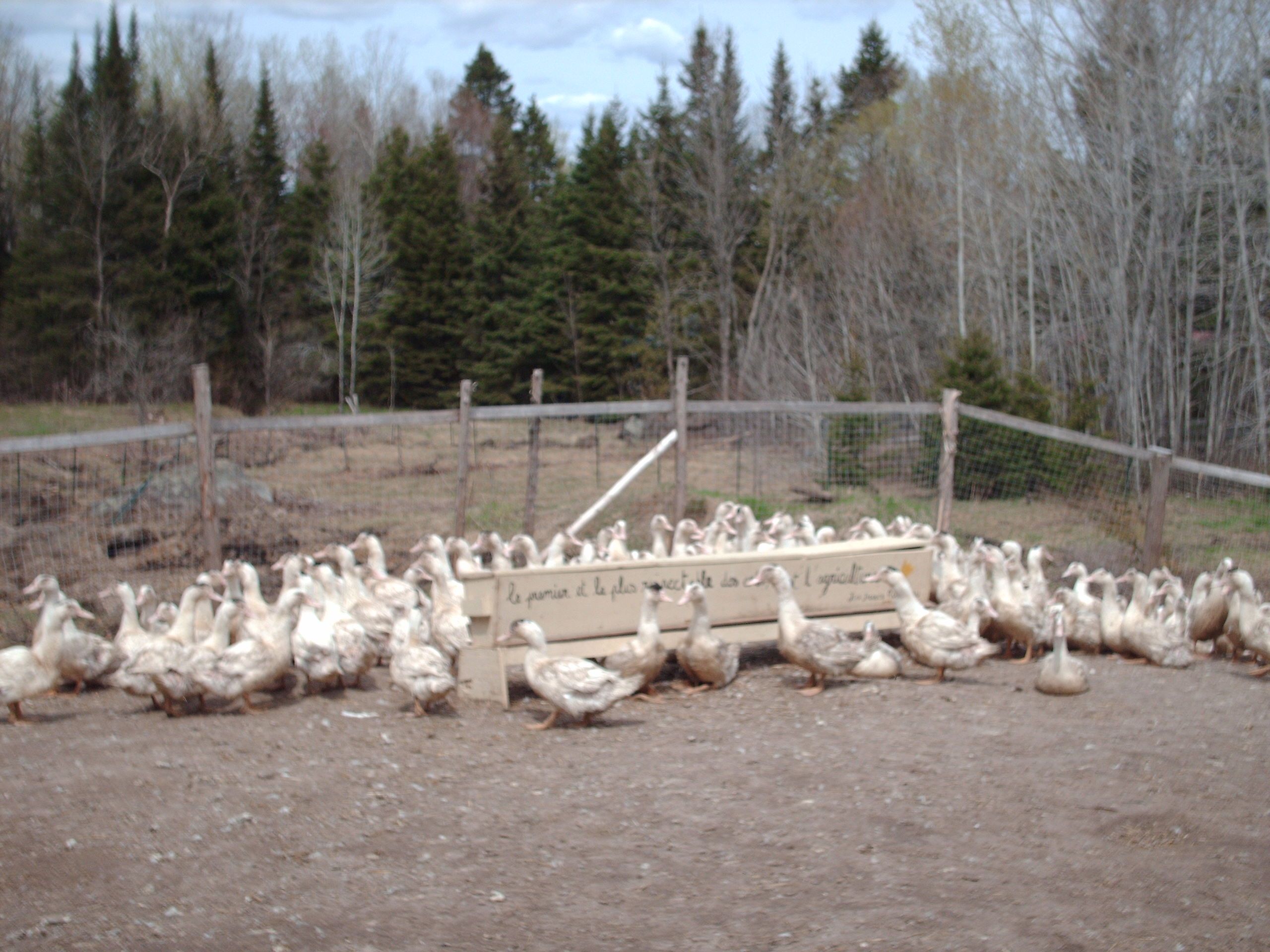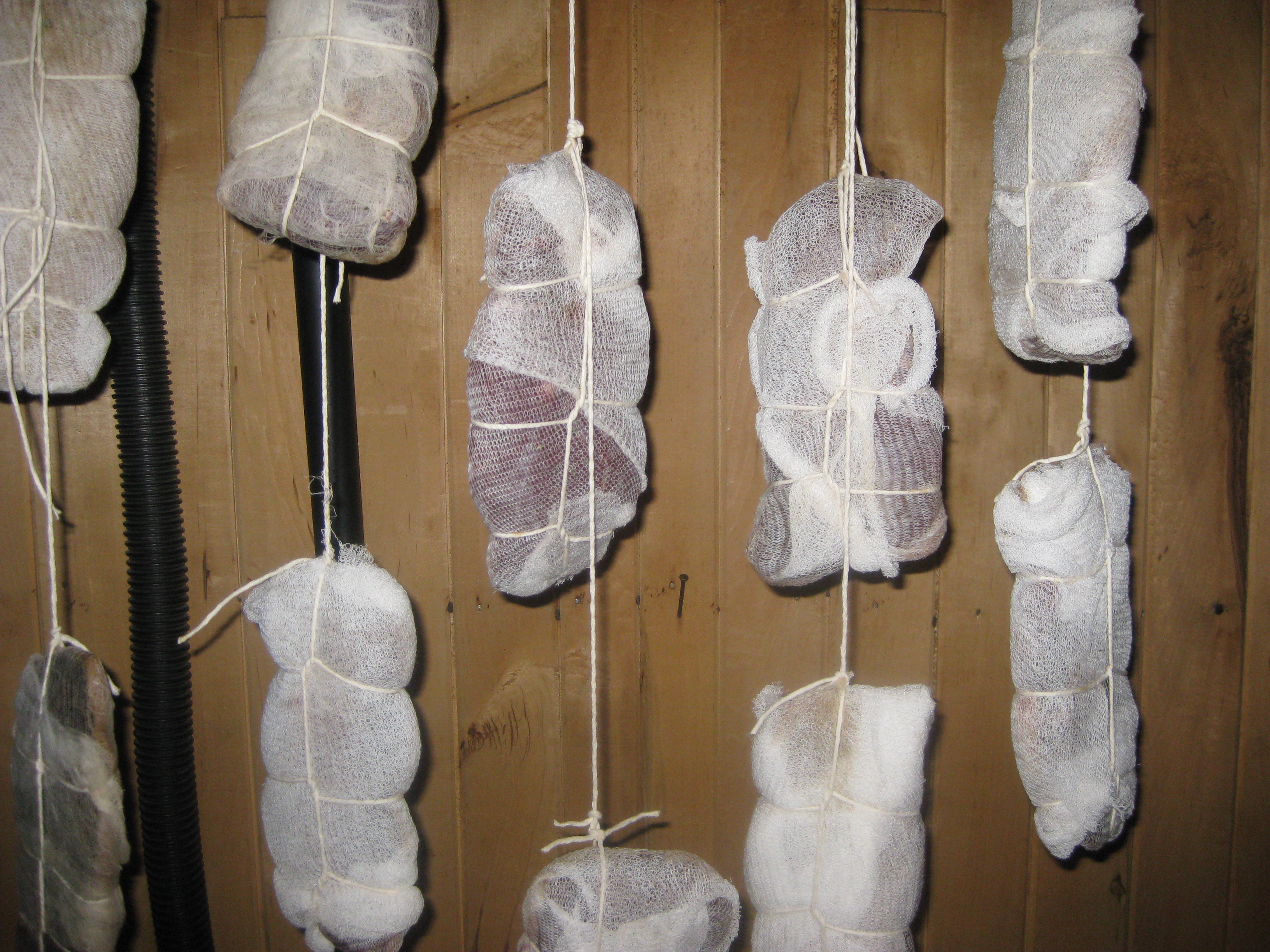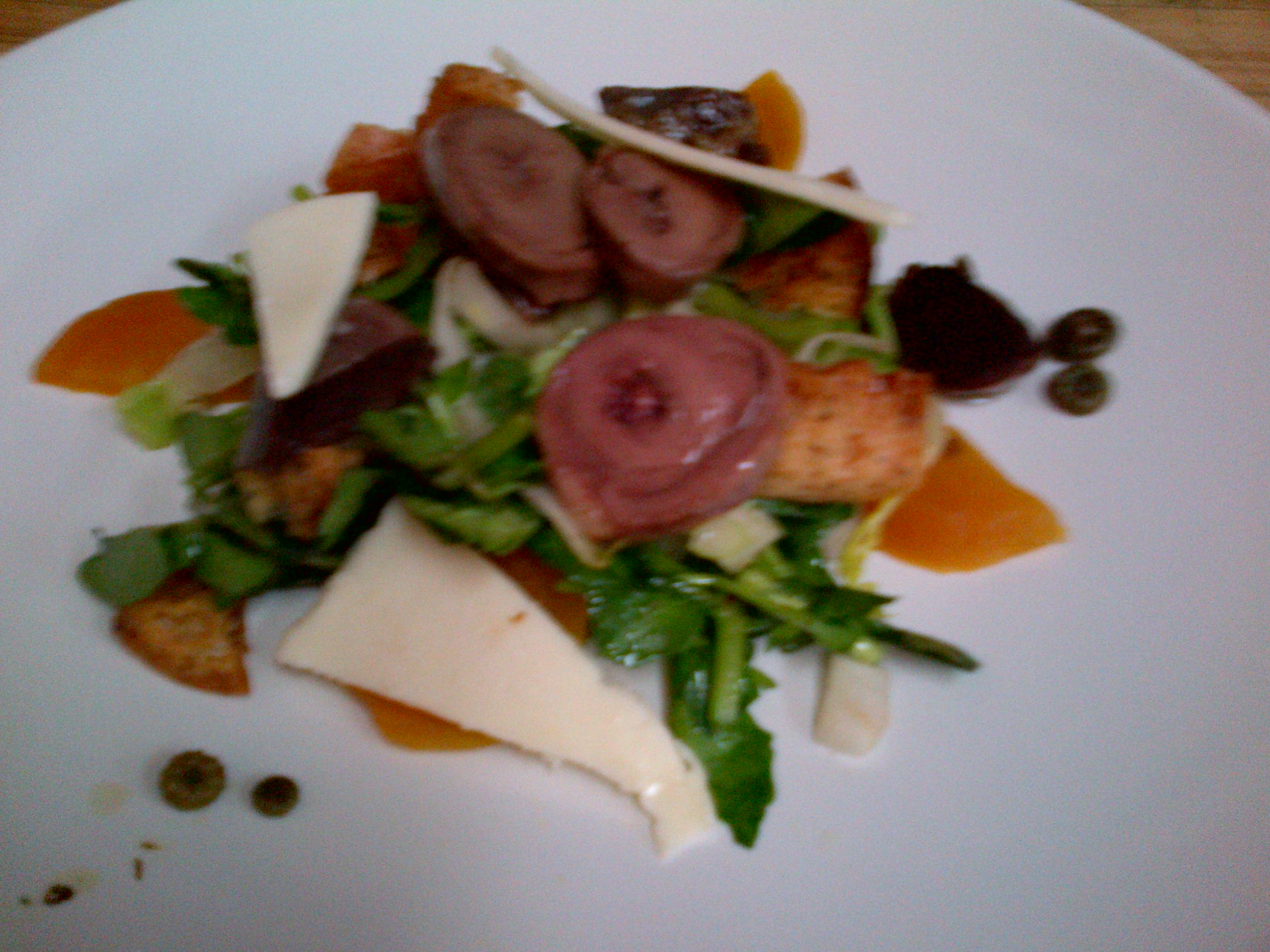Never too much duck
Never too much duck
We finished up our annual duck festival over a week ago, and I’m now well into my Valentine’s menu with ‘aprhodisiac ingredients’ as the theme, but I still have one last duck dinner to go. This one is for a carpenter friend of ours (who has done much work for us recently) and who thinks he and his wife don’t like duck. François and I hardly believe this is possible, so decided to do them a favour and woo them back from the dark side with an enchanting evening of duck dishes. Better knock wood, but I’m counting on a successful turn-around.
In case you didn’t know, duck is my favourite meat. I mention it often, going on about the benefits of duck fat or plugging my favourite duck (Ferme Morgan) whenever possible. I planned on posting a full-on article about duck in all its guises to kick off our duck themed menu in January but never got around to it. The fact that I’m still enamoured with everything duck as I finish up a month of bathing in duck fat, cooking it daily (and nibbling all the odd bits) is a good sign. I just don’t seem to tire of it.
 duck consommé with duck meatballs..With three local breeds (Muscovy, Moulard, Peking) and all their respective parts to play with, there are endless possibilities. I change the menu every year but no doubt, there are the tried and true classics that return although never served the same: Smoked duck breast, duck proscuito, duck consommé, duck eggs, roast duck, duck confit, duck chips, duck egg desserts… Although mostly French inspired, I always have to take one course ‘à l’orientale’ duck being a natural with soy, star anise, sesame and co.
duck consommé with duck meatballs..With three local breeds (Muscovy, Moulard, Peking) and all their respective parts to play with, there are endless possibilities. I change the menu every year but no doubt, there are the tried and true classics that return although never served the same: Smoked duck breast, duck proscuito, duck consommé, duck eggs, roast duck, duck confit, duck chips, duck egg desserts… Although mostly French inspired, I always have to take one course ‘à l’orientale’ duck being a natural with soy, star anise, sesame and co.
 Duck is easy to love and versatile, usually good no matter your inspiration, but it always comes down to pumping up the savoury with salt/umami and spices and then balancing the savoury richness and fat with touches of acidity and sweetness. Pungent, earthy and green notes help there too. Here are some no-brainers:
Duck is easy to love and versatile, usually good no matter your inspiration, but it always comes down to pumping up the savoury with salt/umami and spices and then balancing the savoury richness and fat with touches of acidity and sweetness. Pungent, earthy and green notes help there too. Here are some no-brainers:
Berries, Grape must/saba, aged balsamic, salsaparilla, juniper
Exotic fruit flavours, pineapple, vanilla, sweetgrass, tonka bean
Earthy – Beans, Wild mushrooms, Root vegetables, Cabbage
Herbs – thyme, rosemary, herbes de provence, or basil, coriander..
Spice – ginger, allspice, nutmeg, pepper, star anise, clove, cinnamon, cumin, coriander.. and all such combinations (curry, 5 spice, quatre épices)..
Tart/Piquant to cut the richness – Citrus, good quality vinegar, sumac; mustard, horseradish, ginger, wild ginger, crinkleroot, garlic, chilli heat
Greens for the same reason - garlicky greens, bitter greens, crunchy lettuce
Each duck has its place in my mind. My favourite to eat as is from the pan, is Muscovy; it has a higher meat to fat ratio, the flavour is more complex, and the meat often less tough, allowing me to cook it closer to medium than rare, 15 min stove top is all you need for a supreme.
As with most game birds, the breast and legs should be cooked separately because the legs require a longer cooking time and do better with moist heat in a braise or confit.
My favourite duck to roast whole is the smaller Peking but I don’t bother trying to do a proper ‘Peking’ duck with all the tedious boiling and drying. (However, I do have fond memories of ordering it in fancy Chinese restaurants with the little crepes). I just marinate it for a day and roast it for an hour and a half or so until it’s just done. After an hour or so, you have to pour some water or broth in the pan. After a rest, I pick it all apart, cut it up and mix it into the degreased juices. This makes a great stuffing for a Momofuku style bun or any sandwich, although this year I served it with mushroom fried rice.
 duck terrine, smoked duck, proscuito, torchon, elderberry juniper jelly, rabiole mostarda
duck terrine, smoked duck, proscuito, torchon, elderberry juniper jelly, rabiole mostarda more duck charcuterie
more duck charcuterie
I choose Moulard for charcuterie; Muscovy works fine but is more expensive. My smoked duck is a recipe I concocted years ago which involves curing, then smoking followed by a sear and finish in a low oven. I came up with this method to safely be able to minimize/eliminate nitrites and it turns out that cooking develops more flavour to stand up to the smoke, contrary to drying it raw like most do.

Duck proscuito is a different story, more subtle so simply cured raw and dried. I looked to Paula Wolfert for guidance the first time around, but over the years I’ve tailored my own recipe – I’ve found the seasoning I like and most importantly have discovered the perfect conditions for the 3wk-month drying period. This is the trickiest part of making proscuito – you need a stable, cool, dry, airy dark place to hang your duck for 3 weeks to a month, a fridge is typically too cold and too humid. I make mine once a year in a closet at the restaurant over Christmas when we are closed and the heat is off. Don’t tell the MAPAQ. I don’t have a suitable spot once the mild weather sets in, but that’s ok; I quite like my traditions; the short windows for some wild plants have taught me that some things should only be made once a year.

Duck sausage is a good idea in theory, but to make a traditional sausage succulent as opposed to mealy and dry, you need to add a percentage of fatty pork because duck is naturally too lean and the fat is too soft. I’ve made several successful (and less than stellar) duck sausages, from summer sausage to chorizo to boudin blanc, but this year didn’t want to battle with the fact that pure duck does not easily make good sausage. So I made Mexican chorizo style meat balls. I also made a mousseline style terrine studded with flambéed duck filets and smoked duck, the cream and eggs making up for the lack of fat.

 now that's an egg!
now that's an egg!
Duck eggs – Twice the size of a chicken egg with a bluish tough shell, the duck egg is truly a special ingredient, rich and deeply flavourful, with more yolk than white, and the white is high in protein, very springy. You can use them in savoury or sweet dishes, anywhere/anyhow you would use a chicken egg, but beware of meringue that will jump out of your mixing bowl and take over the kitchen when whipped. François loves duck eggs year round, simply fried or baked with cream and mushrooms; I like them scrambled, more for dinner than breakfast. I particularly liked a Spanish style tortilla dish from a prior menu. They make good crepes too (pure egg diluted with a bit of water). Dessert wise, this year, I made a frozen wintergreen chocolate soufflé and coconut sweet clover cake, but the sky is the limit; in previous years spectacular floating islands, pavlova, lemon meringue pie and multiple ice cream/parfait variations. I always select a duo of egg-based sweets – one that relies on the yolks and the other the whites.. At home, I would opt to keep it simple because fresh duck eggs are difficult to separate white from yolk, and forget about hard-boiled eggs (unless you let them age), they’re a bitch to peel.

 duck egg meringue pie with elderberry/flower
duck egg meringue pie with elderberry/flower

My coup de couer, la salade.. Duck confit salad is not a staple on bistro menus for no reason! There are so many ways to take this theme.. My version consisted of duck gizzards & hearts, bitter greens, duck fat croutons, beets, pickled daisy buds and my wild ‘chimichurri’. It’s the mix of hot & cold, the constrast of luscious savoury dripping confit with bitter greens and a sharp, herbal vinaigrette alongside hits of sweet from the beets and pickles that made this salad a winner. Not only a salad girl like me swoons, but the meat & potato men too, a man’s salad if there ever was.
The confit treatment is really the ideal way to cook gizzards and hearts by the way - painless, a tender result guaranteed. You get the glory of confit (leg) with less time and hassle, no need to cure for days or debone. The longer you leave the gizzards the better, but you need to be careful with the hearts, stopping the cuisson when they are fully cooked but still pinkish (say an hour instead of two)..
Every one associates duck with fattiness, but it is actually a lean meat, you need to keep some of that outside fat for most preparations, which is why it is so good cooked in its own fat.. Don’t forget that duck fat is a good fat!
http://soupnancy.squarespace.com/blog-journalessays/2009/6/20/duck-fat.html
Speaking of fat..


Foie gras (the liver of a Moulard) – This time around my terrine ‘torchon’ was flavoured with elderberry and juniper, which was nice, but I think I prefer my regular sweetgrass - quatre épice treatment. And the ‘incontournable’ pan-seared foie seduces everyone, regardless the preparation. With caramelised onion, parsnip, porcini, Jerusalem artichoke purée and a cider sweetgrass sauce – I had all those earthy flavours mingling with a touch of sweet and zing in the form of malic acid from the apple. Cooking that much foie gras really smokes the place out and is costly, but customers’ faces tell me it’s worth it, the treat of treats, despite any ethical controversy (happily non-existent in these parts). I’m done with that subject anyway. http://soupnancy.squarespace.com/blog-journalessays/2009/2/3/enough-about-foie-gras.html
Duck fat potatoes – I made latkes with crinkleroot, but any potato duck fat dish is delicious: Roasted potatoes, fries, layered in a gratin/ pave/Anna variation, or tortilla (potato onion omelette), you really can’t go wrong.
 potato-duck egg fritatta with duck sausage
potato-duck egg fritatta with duck sausage crinkleroot latkes sizzling in duck fat
crinkleroot latkes sizzling in duck fat
Duck skin chips - So scrumptious they are criminal, they make a terrific crispy garnish more than a snack. I once served them in bowls to munch on with the l’apero but customers ploughed through them, not the ideal start to a 3hour meal. Not to mention too labour intensive to see inhaled for free on my end.
I’ve found the best way to make these duck ‘oreille de crisse’ is to slowly render the skin in the oven for hours, patting dry and cutting out strips before a final crisp up in the oven. Removing the skin from cooked confit legs and putting it in a 250F oven between parchment coated sheetpans for a couple of hours does the trick nicely. Or I coat and deep fry them for utter complete decadence. Once a year is enough for that delicacy.

 bio muscovy supreme with airelle pimbina sauce, duck fat latke, pousses salsifis
bio muscovy supreme with airelle pimbina sauce, duck fat latke, pousses salsifis
If you want to cook duck at home..
Pan-roasting a magret or supreme is the way to go for starters.
You can purchase good quality Moulard & Muscovy duck as well as foie gras at our favourite butcher shop, Le Prince Noir at Marché Jean Talon. http://www.montrealplus.ca/montreal/venues/boucherie-prince-noir-fr
At the Canard Libéré on St-Laurent, a store devoted to duck, you will find Peking Lac Brome duck, as well as all the duck inspiration you need, a wide array of pre-made dishes if you want. http://www.canardsdulacbrome.com/fr/boutiques/
If you can get a hold of a supreme from Morgan farms, it’s worth it. www.fermemorgan.ca
Marinate it, pan-roast and serve it as is, or deglaze and make a sauce.
For one Duck supreme 600g, serves 4p
Heat a good pan to high. Put room temperature duck into pan skin side down and turn the heat down to medium. Leave for 10 minutes, pouring off accumulating fat regularly. Flip over, cook 2 more minutes then turn off the heat. At this point, it should be rare-medium rare. If it feels softer, leave in pan to finish with the residual heat.. Otherwise, pull it out and let it rest a good five min while you make the sauce with the pan drippings. Pour out the last of the fat, deglaze with a splash of wine, some stock, reduce down. Finish to taste with a good cider, balsamic or sherry vinegar, a swirl of butter, salt and pepper ..
My two favourite marinades (a couple of hours or overnight)
Marinade 1: EVO, drops chilli and sesame oil, drops soy, drops maple syrup, drops Sherry vinegar, pinch curry powder, pinch five spice
Marinade 2: EVO, rosemary oil, drops Aged balsamic, drops soy, drops worchesterchire, steak spice, allspice, pepper, thym
For further duck delights, cravings or discoveries, I encourage you to come to Les Jardins Sauvages. It is the star of the menu in winter, but I do serve it year round and have all my duck charcuterie as well as some prepared sous-vide dishes (confit, filets in wild ginger sauce, cassoulet, soup..) available at the Market as well as at the restaurant..
Reader Comments